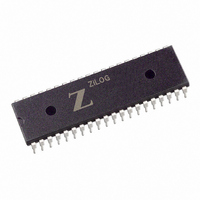Z85C3008PSG Zilog, Z85C3008PSG Datasheet - Page 314

Z85C3008PSG
Manufacturer Part Number
Z85C3008PSG
Description
IC 8MHZ Z8500 CMOS SCC 40-DIP
Manufacturer
Zilog
Series
SCCr
Specifications of Z85C3008PSG
Processor Type
Z80
Features
Error Detection and Multiprotocol Support
Speed
8MHz
Voltage
5V
Mounting Type
Through Hole
Package / Case
40-DIP (0.620", 15.75mm)
Maximum Operating Temperature
+ 70 C
Minimum Operating Temperature
0 C
Mounting Style
Through Hole
Cpu Speed
8MHz
Digital Ic Case Style
DIP
No. Of Pins
40
Supply Voltage Range
5V
Operating Temperature Range
0°C To +70°C
Svhc
No SVHC (18-Jun-2010)
Base Number
85
Rohs Compliant
Yes
Clock Frequency
8MHz
Lead Free Status / RoHS Status
Lead free / RoHS Compliant
Other names
269-3930
Q2456016A
Z85C3008PSG
Q2456016A
Z85C3008PSG
Available stocks
Company
Part Number
Manufacturer
Quantity
Price
Company:
Part Number:
Z85C3008PSG
Manufacturer:
ZILOG
Quantity:
6 100
Company:
Part Number:
Z85C3008PSG
Manufacturer:
Zilog
Quantity:
6
Company:
Part Number:
Z85C3008PSG
Manufacturer:
TOSHIBA
Quantity:
3 500
Part Number:
Z85C3008PSG
Manufacturer:
ZILOG
Quantity:
20 000
Company:
Part Number:
Z85C3008PSGSCC
Manufacturer:
ZILOG
Quantity:
2
- Current page: 314 of 317
- Download datasheet (4Mb)
UM010901-0601
Q. Can the SCC detect multiple aborts?
A. The SCC searched for seven consecutive 1’s on the
Q. How do you send an end of poll (EOP) flag in SDLC
A. To send the EOP message, simply toggle the bit which
Q. When the SCC is programmed for 6 bit sync, how
A. Six bits are sent. The 12-bit sync character sends 12
Q. Do sync patterns (or flags) in data transmissions
A. All leading sync patterns (and all flags) are automati-
Q. How are the sync characters sent at the beginning
A. Load the transmit buffer with the first byte and the sync
receive data line for the abort detection. This condition
may be allowed to cause an external status interrupt.
After these seven 1’s are received, the receiver auto-
matically enters Hunt mode, where it looks for flags.
So, even if more than seven 1’s are received in case
of multiple aborts, only the first sequence of 1’s is sig-
nificant.
loop mode?
idles flags or ones to mark flags, then mark ones. This
produces a zero and more than seven 1’s; an EOP
condition.
are bits sent?
bits.
get stripped and still cause interrupts?
cally stripped if the Sync Character Load Inhibit fea-
ture is programmed. Any data stripped from the
transmission stream cannot cause a receive character
available interrupt but may cause other interrupts
(such as External/Status for Sync/Hunt and special re-
ceive condition for EOM).
of a Bisync frame?
characters are automatically sent out.
Q. How can you determine when the flag has been
A. There are several ways to determine if the flag has
Q. How do the DMA W/REQ lines operate?
A. DMA request lines follow the state of the transmit buff-
Q. How does the SCC handle messages less than
A. A 4-byte message consists of an address, control
completely sent?
been completely sent. This allows the transmitter to be
shut off, or in half duplex the line can be turned around.
This requires a little work by the user because the SCC
does not know when the last flag bit has been shifted
our. The following are some suggestions:
–
–
–
er.
four bytes in length?
word, no data, and 2 bytes of CRC. SDLC defines
messages of less than 4-bytes as an error. It is not de-
fined how the SCC will react, however, as tested by a
SCC user, 4-, 3-, and 2-byte messages cause an inter-
rupt on end of frame, but a 1 byte message does not
cause an interrupt.
Once the flag is loaded into the transmit shift
register, start an external clock. Use the baud rate
generator as the counter.
Tie the transmit line into DCD or an available input
pin, and watch for a zero, or end of flag. If you are
running half-duplex, use the local loopback mode
and watch for the flag to end.
Allow an abort, although this destroys the last
character. Be sure to send a dummy character -
then idle flags after the abort latch is set.
SCC™/ESCC™ User’s Manual
Zilog SCC
7-9
Related parts for Z85C3008PSG
Image
Part Number
Description
Manufacturer
Datasheet
Request
R

Part Number:
Description:
Manufacturer:
Zilog, Inc.
Datasheet:

Part Number:
Description:
Cmos Scc Serial Communications Controller
Manufacturer:
ZiLOG Semiconductor
Datasheet:

Part Number:
Description:
Communication Controllers, ZILOG INTELLIGENT PERIPHERAL CONTROLLER (ZIP)
Manufacturer:
Zilog, Inc.
Datasheet:

Part Number:
Description:
KIT DEV FOR Z8 ENCORE 16K TO 64K
Manufacturer:
Zilog
Datasheet:

Part Number:
Description:
KIT DEV Z8 ENCORE XP 28-PIN
Manufacturer:
Zilog
Datasheet:

Part Number:
Description:
DEV KIT FOR Z8 ENCORE 8K/4K
Manufacturer:
Zilog
Datasheet:

Part Number:
Description:
KIT DEV Z8 ENCORE XP 28-PIN
Manufacturer:
Zilog
Datasheet:

Part Number:
Description:
DEV KIT FOR Z8 ENCORE 4K TO 8K
Manufacturer:
Zilog
Datasheet:

Part Number:
Description:
CMOS Z8 microcontroller. ROM 16 Kbytes, RAM 256 bytes, speed 16 MHz, 32 lines I/O, 3.0V to 5.5V
Manufacturer:
Zilog, Inc.
Datasheet:

Part Number:
Description:
Low-cost microcontroller. 512 bytes ROM, 61 bytes RAM, 8 MHz
Manufacturer:
Zilog, Inc.
Datasheet:

Part Number:
Description:
Z8 4K OTP Microcontroller
Manufacturer:
Zilog, Inc.
Datasheet:

Part Number:
Description:
CMOS SUPER8 ROMLESS MCU
Manufacturer:
Zilog, Inc.
Datasheet:

Part Number:
Description:
SL1866 CMOSZ8 OTP Microcontroller
Manufacturer:
Zilog, Inc.
Datasheet:








